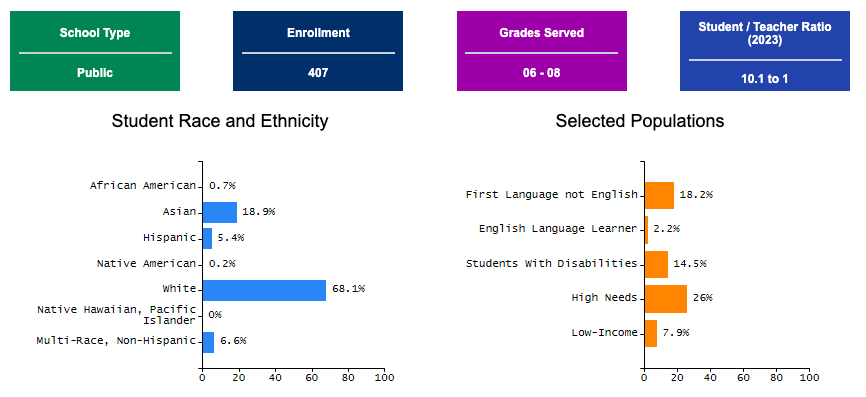Anna test 2
Trottier Middle School Improvement Plan 2024-2027
Executive Summary
This improvement plan is designed to build a robust academic program that nurtures students' diverse talents and prepares them to be independent, responsible, and critical thinkers. Trottier Middle School aims to provide an exemplary educational experience for all learners through collaborative efforts, reflective practices, and strategic use of technology. The Trottier Middle School Improvement Plan supports the District's strategic objectives.
Empowering Learners
Trottier Middle School will continue its overarching goal of empowering learners by implementing innovative and relevant instructional practices. Trottier Middle School will prioritize effectively implementing the Carnegie math curriculum, ensuring sustained growth through continuous professional development, data analysis, and practice adjustments. Additionally, systematic implementation of the new English Language Arts curriculum- EL for grades 6 through 8 will be undertaken, supported by ongoing reflection and professional learning to ensure student success. Our vision for high-level curriculum implementation is cultivating dynamic, student-centered classrooms where learning is active and engaging.
At Trottier Middle School, we strive to create an educational environment that encourages active student participation where every student is involved, contributing their ideas, asking questions, and engaging with the material in meaningful ways. Lessons are designed to be interactive, with opportunities for students to collaborate, discuss, and present their insights. The foundation of our curricula will be to challenge students to think deeply, analyze complex concepts, and solve real-world problems. We encourage students to approach learning with curiosity, asking “why” and “how,” and exploring multiple perspectives. Students will be taught to critically analyze texts, media, and data, developing skills to evaluate sources and construct supported arguments. Lastly, the curricula will connect classroom learning to real-life contexts, allowing students to apply their knowledge in practical situations through projects, experiments, and collaboration to help build relevancy. The science team will review and pilot new curriculum resources to enhance pedagogical approaches. In addition, staff will be provided the necessary training on the AnalyticVue platform to analyze data and build targeted interventions. The World Language department will revise its scope and sequence to offer a year-long French or Spanish experience for sixth graders starting in the 2025-2026 academic year. Furthermore, Trottier will initiate a comprehensive review of its master schedule to introduce more flexibility and dynamic teaching opportunities and foster ongoing collaboration.
Equity of Opportunity
School Council Membership 2024-2025
- Principal:
- Gary Hreschuk
- Teacher/Staff Representatives:
- Danielle Ferarro
- Melanie Amichetti
- Laura Folsom
- Meghan Wixted
- Parent/Community Representatives:
- Lisa D'Souza
- Kevin Robbins
- John Wysocki
- Chris Morgan
Trottier School Improvement Plan Strategic Initiatives Bookmarks
- SIP Initiative #1: High-Quality Instruction for All Learners
- SIP Initiative #2: Culturally Responsive Education
- SIP Initiative #3: Social Emotional Learning
- SIP Initiative #4: Educator Learning and Leadership
Mission
Educate, Inspire, and Challenge
Core Values
- Integrity
- Empathy
- Inclusivity
- Equity
- Perseverance
- Respect
Vision: Profile of a Graduate
Our Students Will Be:
Collaborators
- Enrich the learning of self and others through teamwork.
- Solicit and respect diverse perspectives and contributions.
- Seek, contribute, and react to feedback to achieve shared outcomes.
- Recognize and leverage strengths to build collective commitment, action, and understanding.
Critical and Creative Thinkers
- Transfer and connect knowledge and skills to deepen understanding.
- Demonstrate thinking that is clear, rational, open-minded, and informed by evidence.
- Use disciplinary knowledge and skills in routine and innovative ways.
- Make informed decisions, solve problems, and use a variety of tools to deepen learning.
Communicators
- Articulate thoughts and ideas using oral, written, and non-verbal communication skills for a range of purposes and audiences.
- Listen to decipher meaning, including knowledge, values, attitudes, and intentions.
- Use technological skills and contemporary digital tools to explore and exchange ideas.
Socially and Civically Engaged
- Demonstrate personal, civic, and social integrity through ethical and empathetic behaviors.
- Recognize individual and communal impact on others and the natural world.
- Value and embrace diverse cultures and unique perspectives through mutual respect and open dialogue.
Growth-Oriented
- Cultivate positive attitudes and habits about learning.
- Pursue one's own interests and curiosity to experience new learning.
- Consistently improve the quality of one's own thinking by skillfully analyzing, assessing and reconstructing.
- Persist to accomplish difficult tasks and to overcome academic and personal barriers to meet goals.
Healthy and Balanced
- Develop and demonstrate awareness, sensitivity, concern, and respect to connect with self and others' feelings, opinions, experiences, and cultures.
- Use reflective practices to understand one's personal strengths, challenges, and passions.
- Make choices to support a lifestyle that is healthy, both physically and mentally.
- Demonstrate resilience through the ability to manage emotions, stress, and challenges.
School Data Profile


 Additional settings for Safari Browser.
Additional settings for Safari Browser.


